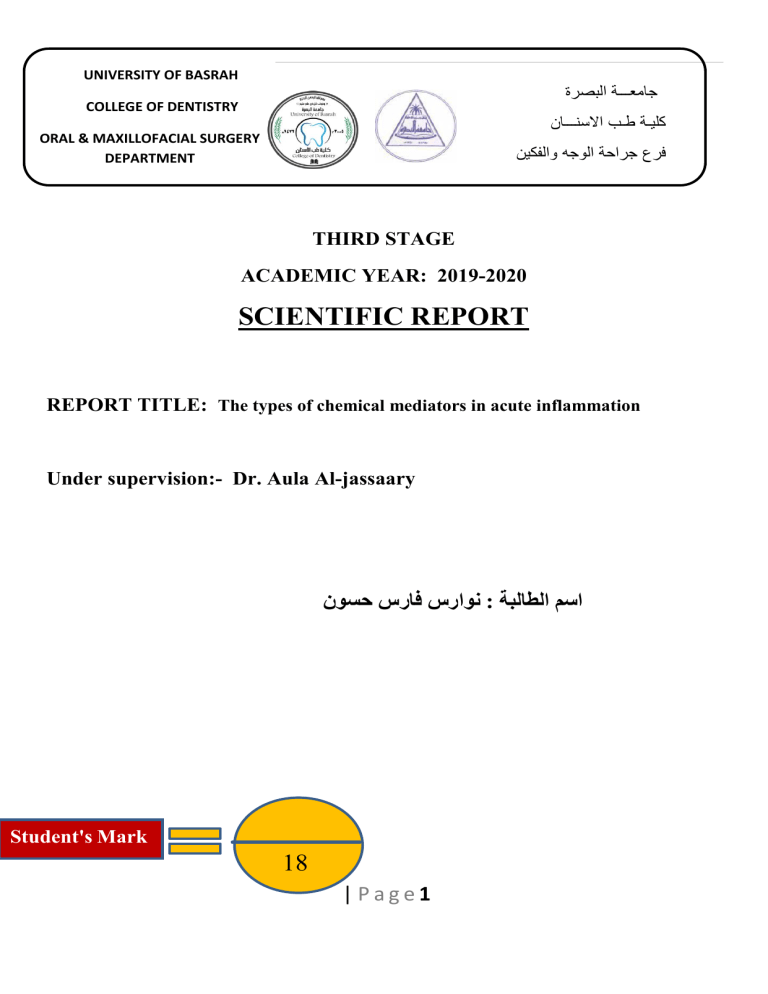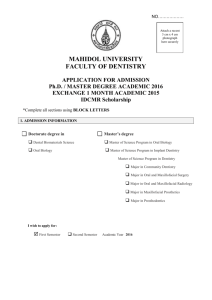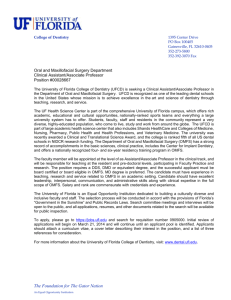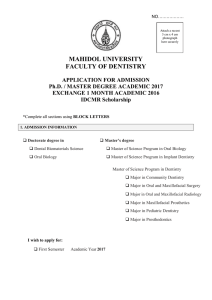
UNIVERSITY OF BASRAH جامعـــة البصرة COLLEGE OF DENTISTRY كليـة طـب االسنـــان ORAL & MAXILLOFACIAL SURGERY DEPARTMENT فرع جراحة الوجه والفكين THIRD STAGE ACADEMIC YEAR: 2019-2020 SCIENTIFIC REPORT REPORT TITLE: The types of chemical mediators in acute inflammation Under supervision:- Dr. Aula Al-jassaary نوارس فارس حسون: اسم الطالبة Student's Mark 18 | Page1 UNIVERSITY OF BASRAH جامعـــة البصرة COLLEGE OF DENTISTRY كليـة طـب االسنـــان ORAL & MAXILLOFACIAL SURGERY DEPARTMENT فرع جراحة الوجه والفكين Introduction: What are mediators? A mediator is a substance or structure that mediates a specific response in a bodily tissue The chemical mediators are responsible for the events in acute inflammation - The production of active mediators is triggered by: 1. microbial products 2. host proteins, such as the proteins of the complement, kinin and coagulation systems ( these are themselves activated by microbes and damaged tissues) Mediators derived from plasma or from cells. - Most mediators perform their activity by initially binding to specific receptors on target cells. However, some have direct enzymatic or toxic activities. as shown : The role of chemical mediators in the acute inflammatory response.At the site oftissue injury or bacterial invasion, both exogenous and endogenous chemical mediators are liberated. Classic endogenous prostaglandins and mediators such as leukotrienes dilate vasculatures, enhance permeability of capillaries, increase blood flow, and stimulate the recruitment of neutrophils (PMNs) to form inflammatory exudate. Novel chemical mediators are produced in the evolution and resolution of the exudate that regulate tissue responses.. The black | Page2 UNIVERSITY OF BASRAH جامعـــة البصرة COLLEGE OF DENTISTRY كليـة طـب االسنـــان ORAL & MAXILLOFACIAL SURGERY DEPARTMENT فرع جراحة الوجه والفكين arrow denotes leukocyte traffic from venules and the dashed arrow denotes exogenous, i.e., bacterial components and chemoattractants. • Active mediators are produced only in response to various stimuli like microbial products • Life span of mediators are very short • One mediator can stimulate the release of other like complement activation cause release of histamine and cytokines Vasoactive Amines: Histamine and Serotonin Acts on blood vessels , First mediators Histamine • Mast cells are richest source of histamine. • Histamine stored as granules and released by degranulation in response to various stimuli 1. Physical injuries 2. Anti bodies mediated - hypersensitivity reaction 3. Complement products- anaphyltoxin C3a, CSa . 4. Neuropeptides (e.g., substance P) and cytokines (IL1, IL8) • Histamine causes dilation of arterioles and increases the permeability of venules. • | Page3 UNIVERSITY OF BASRAH جامعـــة البصرة COLLEGE OF DENTISTRY كليـة طـب االسنـــان ORAL & MAXILLOFACIAL SURGERY DEPARTMENT فرع جراحة الوجه والفكين Principal mediator of the immediate transient phase it • It increased vascular permeability, producing inter endothelial gaps in venules . • Act via H1 receptors present on microvascular endothelial cells. Serotonin ((5-hydroxytrypta mine) • preformed mediator • Present in platelets and certain neuroendocrine cells like GIT. • Primary function is as a neurotransmitter. • Vasoconstriction. Arachidonic Acid Metabolites • The lipid mediators prostaglandins and leukotrienes are produced from arachidonic acid (AA) present in membrane phospholipids • Stimulate vascular and cellular reactions. • Arachidonic acid derived from dietary sources or by conversion from the linoleic acid. • Mechanical, chemical, and physical stimulator other mediators (e.g., CSa ) release AA from membrane phospholipids through the action of cellular phospholipases, mainly phospholipase A2. • Phospholipase A2 Activation occur via increase in cytosolic Ca 2 + and kinase in response to externa l stimuli. | Page4 UNIVERSITY OF BASRAH جامعـــة البصرة COLLEGE OF DENTISTRY كليـة طـب االسنـــان ORAL & MAXILLOFACIAL SURGERY DEPARTMENT فرع جراحة الوجه والفكين Prostaglandins • Produced by mast cells , macrophages , endothelial cells,. • It involved in vascular and systemic reactions of inflammation. • COX-1 & COX-2 is involved in synthesis of prostaglandins. • COX -1is produced in response to inflammatory stimuli and is also constitutively expressed • COX2 is induced by inflammatory stimuli. Throm boxane A2 (TxA2 ): derived by action of thromboxa ne synthase present in platelets. Functions : 1. platelets aggregation 2. Vasoconstrictions 3. it is unstable and converted to inactive forms TxB2. | Page5 UNIVERSITY OF BASRAH جامعـــة البصرة COLLEGE OF DENTISTRY كليـة طـب االسنـــان ORAL & MAXILLOFACIAL SURGERY DEPARTMENT فرع جراحة الوجه والفكين Prostacyclin( PGl2) : formed by action of prostacyclin synthase present in vascular endothelium. Functions: 1. increase vascular permeability 2. inhibit platelets aggregation. • PGD2 produced by mast cells along with PGE2. • It causes vasodilation and increases the permeability of postcapillary venules, thus potentiating edema formation. • PGF2- stimulates contraction of uterine and bronchial smooth muscles and small arterioles. • Prostaglandins involved in the pathogenesis of pain and fever in inflammation. • PGE2 is hyperalgesic makes the skin hypersensitive to painful stimuli. | Page6 UNIVERSITY OF BASRAH جامعـــة البصرة COLLEGE OF DENTISTRY كليـة طـب االسنـــان ORAL & MAXILLOFACIAL SURGERY DEPARTMENT فرع جراحة الوجه والفكين Cytokines and Chemokines: Cytokines are proteins produced by many cell types (activated lymphocytes, macrophages, and dendritic cells). mediate and regulate immune and inflammatory reactions. Tumor Necrosis Factor (TNF) and Interleukin-1( IL-1) • Roles in leukocyte recruitment. • promoting adhesion of leukocytes to endothelium and their migration through vessels. • Produced by - macrophages and dendritic cells. • TNF also via T lymphocytes and mast cells. • Stimulus for secretion- microbial products, immune complexes, foreign bodies, physical injury, and a variety of other inflammatory stimuli. • TNF production is induced by TLRs and other microbial sensors. | Page7 UNIVERSITY OF BASRAH جامعـــة البصرة COLLEGE OF DENTISTRY كليـة طـب االسنـــان ORAL & MAXILLOFACIAL SURGERY DEPARTMENT فرع جراحة الوجه والفكين Chemokines Chemokines are a family of small (8 to 10 kD) proteins that act primarily as chemoattractant for specific types of leukocytes. About 40 different chemokines and 20 different receptors for chemokines have been identified. Classification of chemokines : Four major groups: 1. . C-X-C chemokines: • Have one amino acid residue separating the first two of the four conserved cysteine residues. • Act primarily on neutrophils. • Secreted by macrophages, endothelial cells. • function- Activation and chemotaxis of neutrophils | Page8 UNIVERSITY OF BASRAH جامعـــة البصرة COLLEGE OF DENTISTRY كليـة طـب االسنـــان ORAL & MAXILLOFACIAL SURGERY DEPARTMENT فرع جراحة الوجه والفكين • Eg. IL-8 2. C-C chemokines- :have the first two conserved cysteine residues adjacent . • It includes- monocyte chemoattractant protein (MCPl), eotaxin, macrophage inflmmatory proteinl a (MIPla). • RANTES (regulated and normal T cell expressed and secreted) • Attract monocytes, eosinophils, basophils and lymphocytes. , eotaxin selectively recruits eosinophils. 3. C chemokines -lack the first and third of the four conserved cysteines. • e.g., lymphotactin • • specific for lymphocytes. • Chemokines mediate their activities by binding to seven-trans membrane G proteincoupled receptors. 1. CX3C chemokines-contain three amino acids between the two cysteines. • eg:- fractalkine exist in two forma. • cell surface bound protein- promotes strong adhesion of monocytes and T cells. • soluble form-derived by proteolysis of the mem brane bound protein. • Potent chemo-attractant. | Page9 UNIVERSITY OF BASRAH جامعـــة البصرة COLLEGE OF DENTISTRY كليـة طـب االسنـــان ORAL & MAXILLOFACIAL SURGERY DEPARTMENT فرع جراحة الوجه والفكين • Functions of chemokines- • In acute inflammation-stimulate leukocyte attachment to endothelium by acting on leukocytes to increase the affinity of integrins. • Chemotaxis • • Maintenance of tissue architecture • homeostatic chemokines-produced constitutively in tissues Complement System • The complement system is a collection of soluble proteins and membrane receptors that function mainly in host defense against microbes and in pathologic inflammatory reactions. • The system consists of more than 20 proteins, some of which are numbered Cl through C9. • functions in both innate and adaptive immunity | P a g e 10 UNIVERSITY OF BASRAH جامعـــة البصرة COLLEGE OF DENTISTRY كليـة طـب االسنـــان ORAL & MAXILLOFACIAL SURGERY DEPARTMENT فرع جراحة الوجه والفكين References: -Robbin basic pathology. | P a g e 11



